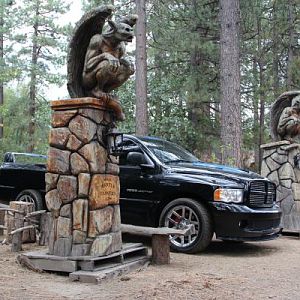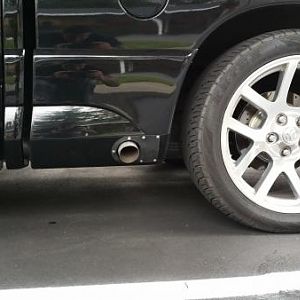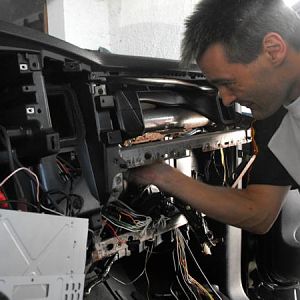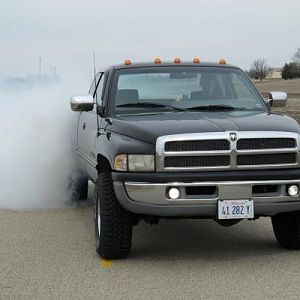You are using an out of date browser. It may not display this or other websites correctly.
You should upgrade or use an alternative browser.
You should upgrade or use an alternative browser.
Bone's Engine Pull - Part Deux
- Thread starter Bone
- Start date
I agree Bone those rods are bent. (The zoom feature is great for seeing that kind of problem on a pc!)
Now the question that I have is why? I have never ever bent a rod. I have destroyed pistons by over revving, I have yanked skirts off of them, jammed valves through the dome more times than I care to admit (valve float) and I have destroyed rod journals due to too much boost..but never bent a rod...
Can someone tell me the two or three most common reasons that a rod would bend, but the piston not be destroyed??? Seems the piston would be the most fragile part of this process and that they should disintegrate long before a rod would bend....???
Some one help my brain wrap around this issue please...
Muzzy...Jerry...Silverback???
Now the question that I have is why? I have never ever bent a rod. I have destroyed pistons by over revving, I have yanked skirts off of them, jammed valves through the dome more times than I care to admit (valve float) and I have destroyed rod journals due to too much boost..but never bent a rod...
Can someone tell me the two or three most common reasons that a rod would bend, but the piston not be destroyed??? Seems the piston would be the most fragile part of this process and that they should disintegrate long before a rod would bend....???
Some one help my brain wrap around this issue please...
Muzzy...Jerry...Silverback???
nycstev
Full Access Member
I would say it could have been an initial machining problem such as a rod journal or piston pin alignment issue . At the right moment the load from the piston was not transmitted axially from the piston to the crank resulting in a bending failure.
And for whatever reason , at that moment , the force required to bend the rod was < the force needed to cause the pin or piston to fail in shear.
And for whatever reason , at that moment , the force required to bend the rod was < the force needed to cause the pin or piston to fail in shear.
Last edited:
If the pins and journals were ok, then that would seem to indicate to my feeble mind that ignition occurred at the wrong time, when the rod was at its most vulnerable angle...or possibly...a partial detonation not at top dead center? Now it that happens to two rods...it probably means detonation in more than one cylinder...?????
nycstev
Full Access Member
It doesnt matter where the rod is , the load throught the rod is axial so I wouldn't think there isn't any vulnerable angle( straight ) . (Theres other forces but if aligned are not great). Bear in mind Im talking about the Plane of the failure. There are 2 planes ( the fat part and the slender part).Prof said:If the pins and journals were ok, then that would seem to indicate to my feeble mind that ignition occurred at the wrong time, when the rod was at its most vulnerable angle...or possibly...a partial detonation not at top dead center? Now it that happens to two rods...it probably means detonation in more than one cylinder...?????
FSTJACK
Full Access Member
Prof said:Now the question that I have is why? I have never ever bent a rod. I have destroyed pistons by over revving, I have yanked skirts off of them, jammed valves through the dome more times than I care to admit (valve float) and I have destroyed rod journals due to too much boost..but never bent a rod...
Can someone tell me the two or three most common reasons that a rod would bend, but the piston not be destroyed??? Seems the piston would be the most fragile part of this process and that they should disintegrate long before a rod would bend....???
The most commom cause for bending a connecting rod is to "hydraulic" the cylinder associated with that rod. Having a high volume of liquid in the cylinder that will not compress. Fuel or water; ie coolant. It can also be done with too high a working cylinder pressure for the rod to handle. Cylinder pressure is what makes HP and torque. That is why a rod has a range in which it will operate safely. Another cause can be the piston sticking in the bore and binding itself to the cyl wall.
In Bone's situation this high cyl pressure appears to be the reason for failure. The rod itself was not up to the task.
The stock rod failed beacuse it was past its design limits. Usually the rod will break close to the big end on a senario with excessive cyl pressure under running high loads. Bent rods are very common in big HP turbo and blower motors.
Bone is very lucky the rod did not break in the middle with catastrophic consequences. As this will uaually "window* the block and pan making the parts scrap.
Pistons are usually destroyed by detonation or excessive heat (high flame front on fuel motors). Detonation shatters the rings and ring lands as well as causing the rod bearing to flake, pound and delaminate.
*"Window the block" is a racers term for knocking a hole in or knocking chunks out of the block, usually caused by a connecting rod breaking.
nycstev
Full Access Member
Roy
I think we're talking about two different things. Im talking about actual geometry that was involved in rod failure and your looking for a set of conditions which could have caused this failure. It could have been both !
I think we're talking about two different things. Im talking about actual geometry that was involved in rod failure and your looking for a set of conditions which could have caused this failure. It could have been both !
Damn, I just love to learn! I think I can feel my brain growing...and it is a nearly sexual feeling!
Thanks Jack and Steve! You guys turn me on!


Thanks Jack and Steve! You guys turn me on!
nycstev
Full Access Member
Ok Fst jck posted conditions which pushed the rod past its factor of safety.
Roy your point of which would fail first is a good one, the piston assembly or the rod? Did Bone have stock or upgraded pistons?:dontknow:
Roy your point of which would fail first is a good one, the piston assembly or the rod? Did Bone have stock or upgraded pistons?:dontknow:
nycstev
Full Access Member
Prof said:Damn, I just love to learn! I think I can feel my brain growing...and it is a nearly sexual feeling!
Thanks Jack and Steve! You guys turn me on!


This is called intellectual masturbation.
Diamond forged pistons
Stock Piston Rods (but balanced)
Too much HP, during Mopar Nats run when I hit the NOS. New setup and more NOS was more than they could handle.
Yes, I was lucky they didn't break.
Next, I will be inspecting the cylinder walls at the machine shop. That will determine my next step.
Stock Piston Rods (but balanced)
Too much HP, during Mopar Nats run when I hit the NOS. New setup and more NOS was more than they could handle.
Yes, I was lucky they didn't break.
Next, I will be inspecting the cylinder walls at the machine shop. That will determine my next step.
BOOMER
Full Access Member
bone shoot a picture of the head gasket for those cylinders.Bone said:Diamond forged pistons
Stock Piston Rods (but balanced)
Too much HP, during Mopar Nats run when I hit the NOS. New setup and more NOS was more than they could handle.
Yes, I was lucky they didn't break.
Next, I will be inspecting the cylinder walls at the machine shop. That will determine my next step.
you either;
stuck injector open
seeped some coolant in
do you use a wet NOS system? if so the fuel could have puddled in the intake then was forced into that cylinder and hydro'd it.
either way, it looks more fuel hydro'd that cylinder, and the others look they were wet, but that particular one got the most at that time, and ther you go.
I know that Bone does not want to hear this but it just seems to me...
If you pull the heads...you should drop the pan, add forged rods, forged pistons, new push rods, new lifters, anything less is just penny wise but pound foolish.
I really think the same about the heads, if you are going to port them, go all the way through the heads with all the right things for the valve train too...
I know, big dollars...but the old adage is:
"do it right the first time"
Even if it delays the process because you have to wait to gather the coin necessary.
If you pull the heads...you should drop the pan, add forged rods, forged pistons, new push rods, new lifters, anything less is just penny wise but pound foolish.
I really think the same about the heads, if you are going to port them, go all the way through the heads with all the right things for the valve train too...
I know, big dollars...but the old adage is:
"do it right the first time"
Even if it delays the process because you have to wait to gather the coin necessary.
Taliban Dan
New Member
- Joined
- Apr 3, 2007
- Messages
- 29
- Reaction score
- 0
The pistons were diamond and we used stock rods all were balanced bone was running 8 psi on the blower which on the dyno no nitrous was over 600 at the wheels thru auto trans. Now add nitrous (wet kit) and the rod was not up to the task of holding the combustion pressure. In this case rod was the weak link. The head gaskets are fine they held up without any problems block was also studded a.r.p . Next is more boost and all forged !!!!!!! Nawssss maybe :evil:
Outstanding!
10.49 Here we come....
Don't know why I pulled that number...
Whooop, Whooooooop!
10.49 Here we come....
Don't know why I pulled that number...
Whooop, Whooooooop!
Yep, I agree with Jack on this one. Cylinder pressures were to high, and that is the thing with nitrous, it's just about instantanous. It doesn't build slowly like a turbo or blower will.
Another thing is if the nitrous is hit at to low of a rpm.
Now I'm really curious about something here. In the earlier pictures it showed one of the pistons cocked by .100 to .150 in the cylinder. I wouldn't care how that cylinder mic'd, I would replace that liner. Hell, I would replace the liners in both 7 and 9. If you don't you run a good chance of losing another engine when the cylinder pressures get high again.
Another thing is if the nitrous is hit at to low of a rpm.
Now I'm really curious about something here. In the earlier pictures it showed one of the pistons cocked by .100 to .150 in the cylinder. I wouldn't care how that cylinder mic'd, I would replace that liner. Hell, I would replace the liners in both 7 and 9. If you don't you run a good chance of losing another engine when the cylinder pressures get high again.
1000hpOdyssey
Full Access Member
- Joined
- Jan 4, 2007
- Messages
- 138
- Reaction score
- 0
vacuum issue
Bone,
Since you are going to run a larger lower pulley and a smaller upper, you will end up with more boost than I am running. What do you plan to do to decrease the turbulence induced vacuum behind the throttle body? I am thinking about taking Tony's suggestion and trying a splitter in the Roe intake to keep the air from just slamming in the back wall.:dontknow:
I am thinking about taking Tony's suggestion and trying a splitter in the Roe intake to keep the air from just slamming in the back wall.:dontknow:
Bone,
Since you are going to run a larger lower pulley and a smaller upper, you will end up with more boost than I am running. What do you plan to do to decrease the turbulence induced vacuum behind the throttle body?
Where do we find a venturi expert?
Who is the supercharger air flow expert?
I think we have an issue here that needs some out-of-the-box thinking...
I do love the creativity of Stinkers idea...what other ideas are out there????
How about ram air? How about a small turbo on the front of the intake?
Any one every heard of compressed air being used to increse air flow?
Is there a way to increase the size of the throttle body constriction point?
Can we add an opening else where in the throttle body to enhance air flow...come on thinkers get it in gear.
Who is the supercharger air flow expert?
I think we have an issue here that needs some out-of-the-box thinking...
I do love the creativity of Stinkers idea...what other ideas are out there????
How about ram air? How about a small turbo on the front of the intake?
Any one every heard of compressed air being used to increse air flow?
Is there a way to increase the size of the throttle body constriction point?
Can we add an opening else where in the throttle body to enhance air flow...come on thinkers get it in gear.
Support Us
Become A Supporting Member Today!






















